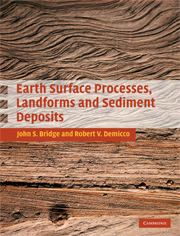Book contents
- Frontmatter
- Contents
- Acknowledgments
- Figure credits
- PART 1 Introduction
- PART 2 Production of sediment at the Earth's surface
- PART 3 Fundamentals of fluid flow, sediment transport, erosion, and deposition
- 5 Unidirectional turbulent water flow, sediment transport, erosion, and deposition
- 6 Air flow, sediment transport, erosion, and deposition
- 7 Multidirectional water flow, sediment transport, erosion, and deposition
- 8 Movement of sediment by gravity
- 9 Generation and movement of volcaniclastic sediment
- 10 Ice flow, sediment transport, erosion, and deposition
- 11 Biogenic and chemogenic depositional structures
- 12 Post-depositional deformation of soft sediment
- PART 4 Environments of erosion and deposition
- PART 5 Sediment into rock: diagenesis
- PART 6 Long-term, large-scale processes: mountains and sedimentary basins
- References
- Appendix: Methods of study of Earth surface processes, landforms, and sediments
- Index
- Plate section
7 - Multidirectional water flow, sediment transport, erosion, and deposition
from PART 3 - Fundamentals of fluid flow, sediment transport, erosion, and deposition
Published online by Cambridge University Press: 05 June 2012
- Frontmatter
- Contents
- Acknowledgments
- Figure credits
- PART 1 Introduction
- PART 2 Production of sediment at the Earth's surface
- PART 3 Fundamentals of fluid flow, sediment transport, erosion, and deposition
- 5 Unidirectional turbulent water flow, sediment transport, erosion, and deposition
- 6 Air flow, sediment transport, erosion, and deposition
- 7 Multidirectional water flow, sediment transport, erosion, and deposition
- 8 Movement of sediment by gravity
- 9 Generation and movement of volcaniclastic sediment
- 10 Ice flow, sediment transport, erosion, and deposition
- 11 Biogenic and chemogenic depositional structures
- 12 Post-depositional deformation of soft sediment
- PART 4 Environments of erosion and deposition
- PART 5 Sediment into rock: diagenesis
- PART 6 Long-term, large-scale processes: mountains and sedimentary basins
- References
- Appendix: Methods of study of Earth surface processes, landforms, and sediments
- Index
- Plate section
Summary
Introduction
Water currents that periodically reverse direction are associated with (1) water surface waves formed by the wind; (2) tidal waves caused by the gravitational attractions between the Earth, Moon, and Sun; and (3) tsunami waves caused by earthquakes, landslides, volcanic eruptions, and meteorite impacts. Temporal and spatial variation in the velocity and direction of these currents is complicated. These waves undergo fundamental changes as they move into shoaling water and towards land, further modifying the associated currents. These waves also normally act together in the sea, and it is common for unidirectional currents to be superimposed upon the wave currents. For example, the wind that acts on the water surface to produce wind waves also drags surface water in the general direction of the wind. Therefore, water currents associated with these various types of waves are truly multidirectional. Reviews of wind waves, tidal waves, and associated water currents and sediment transport are given by Defant (1958), J. R. L. Allen (1970, 1985), Komar (1976, 1998), Bowden (1983), Pond and Pickard (1983), Sleath (1984), Fredsoe and Deigaard (1992), Nielsen (1992), and P. A. Allen (1997). Reviews of tsunamis and their effects on the Earth include Iida and Iwasaki (1983), Mader (1988), Dawson (1994, 1999), Shiki et al. (2000), Bryant (2001), and Satake (2005). Wind waves and associated wind-drag currents will be discussed first, then tidal waves, and finally tsunami waves.
- Type
- Chapter
- Information
- Earth Surface Processes, Landforms and Sediment Deposits , pp. 213 - 254Publisher: Cambridge University PressPrint publication year: 2008



